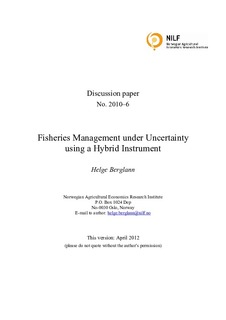| dc.contributor.author | Berglann, Helge | |
| dc.date.accessioned | 2017-12-08T11:01:33Z | |
| dc.date.available | 2017-12-08T11:01:33Z | |
| dc.date.created | 2017-12-07T17:18:03Z | |
| dc.date.issued | 2010-09 | |
| dc.identifier.uri | http://hdl.handle.net/11250/2469740 | |
| dc.description.abstract | This article considers the use of a hybrid instrument to regulate .sheries, comparing this instrument with quantity control and linear taxation in regards to economic yields and the risk of resource deple- tion. Hybrid instruments have shown to be central in studies with static models but have hardly ever been explored in the context of dy- namic .sheries. A numerical example concerned with a single-species demersal .shery where the stock estimate is uncertain indicates that a combination of price and quantity control in the form of a strictly convex tax on landings is clearly superior to quantity control. When cost uncertainty is involved, it can also prove more e¢ cient than the price instrument. | nb_NO |
| dc.language.iso | eng | nb_NO |
| dc.publisher | Norsk institutt for landbruksøkonomisk forskning | nb_NO |
| dc.relation.ispartof | NILF Discussion Papers | |
| dc.relation.ispartofseries | NILF Discussion Papers;2010-6 | |
| dc.subject | Fiskeriforvaltning | nb_NO |
| dc.subject | Fisheries Management | nb_NO |
| dc.subject | Usikkerhet | nb_NO |
| dc.subject | Uncertainty | nb_NO |
| dc.title | Fisheries Management under Uncertainty using a Hybrid Instrument | nb_NO |
| dc.type | Research report | nb_NO |
| dc.description.version | publishedVersion | nb_NO |
| dc.subject.nsi | VDP::Statsvitenskap og organisasjonsteori: 240 | nb_NO |
| dc.subject.nsi | VDP::Political science and organisational theory: 240 | nb_NO |
| dc.source.pagenumber | 30 | nb_NO |
| dc.source.issue | 6 | nb_NO |
| dc.identifier.cristin | 1524467 | |
| cristin.ispublished | true | |
| cristin.fulltext | original | |
